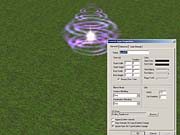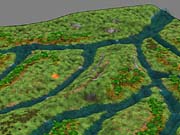Battle Realms Designer Diary #6
Ed Del Castillo returns for another designer diary installment. This time, he talks all about the tools his designers use to create Battle Realms.
Entry #6 - 03/01/01
Liquid Entertainment
Game development looks easy from an outsider's perspective. I've often been asked why major game titles take two years or more to make. "It's just a game!" non-gamers cry. "Come up with a fun idea, slap some art together, and throw it in a box--how hard can it be?"
Any developer who's worked a 24-hour day to squash that last crash bug knows better. Getting a game all the way from the original concept to the store shelf is a difficult, lengthy, and often chaotic process. Schedules that were easily achievable when the project began have to be adjusted as technology develops. Art that was cutting-edge ends up looking dated two years down the road. Designers, artists, and programmers wrestle with difficult technical challenges while constantly chasing a moving target: the changing tastes of a fickle gaming audience.
It's easy to get overwhelmed. Some teams run headfirst into the process without stopping for code design, programming from day one and never stopping until they ship. Other teams drag out the design process for months or even years, afraid to actually start making the game. Still others are constantly playing catch-up, reacting to problems rather than predicting them.
But a good team understands that the first phase of a game's development cycle has very little to do with making the game itself and everything to do with making the best possible tools.

Right Tool for the Right Job
From very basic art exportation utilities to polished editors that ship with the game, development tools come in all sizes and shapes. A tool is a miniproject in itself; often, companies have one or more programmers devoted entirely to writing and updating tools for the length of the project. The purpose of all these tools is to provide the designers, programmers, and artists effective means of bringing a game to life--a flexible method to modify game assets throughout the development cycle. Tools are the team's interface with the gameworld.
For Battle Realms, several game systems required complex tools. The Model Master was one of the first and also one of the most important. Turning the artist's complex 3D models into useable game data was a detail-oriented task that fell on the design department, and the Model Master made that job manageable, though never exactly easy. Several plug-ins were written for our artists' 3D package that allowed them to extract a character's animations, mesh, and textures. The Model Master then recombined all the pieces into a model that could be used in the game.
One of the core principles behind the Battle Realms design was that the world had to be alive. Everything would be in constant motion, with plenty of eye candy to go around. This meant particle effects, and lots of them, which meant we needed a tool to quickly generate new effects--the Particle Master. With more functionality than most commercial software packages, the Particle Master is easy to use, and it has allowed us to build everything from raging fires and billowing smoke to gentle rain and expanding water ripples. The time spent polishing the Particle Master's interface resulted in a solid editor that could be passed off to anyone who had the time and artistic eye to create spectacular effects.
The Tool That Built the World
The World Editor was the tool that would bring everything together--units, buildings, particles, and terrain--to create the scenarios and multiplayer battlegrounds of our fantasy universe. It was the final destination for all game assets and the program that the designers would spend the majority of the project using. It had to be good.

Our experiences with other map editing tools on previous projects helped us avoid common pitfalls. We knew the editor would go through several revisions as game features were added, and we wanted to avoid having to throw out all the existing maps every few days. From day one, we always made sure that the editor included a "map checker" utility, allowing us to update existing maps made with earlier versions. This seemingly small feature has saved countless hours. Some of the maps that will appear in the final game were begun with an earlier version of the editor a year or more ago.
We also needed our editor to be simple to use, so that anyone could pick it up quickly and start making maps. At a start-up company, everyone wears many hats, and if the artists had downtime late in the project, an easy-to-use map editor would mean that they could be handed design tasks with hardly any ramp-up time.
The final tool is definitely a success. Users "paint" height and texture rather than typing in values or placing individual texture tiles, the interface follows standard Windows and paint program conventions, brushes and other user settings can be customized and saved, and camera movement is simple and intuitive. Not only does the World Editor get the job done, but it's also so much fun to use that several Liquid employees have picked it up in their spare time and made their own multiplayer maps.
Time spent building good development tools is never time wasted. Tools that are user-friendly and relatively bug-free not only speed production of the game itself, but they also create the opportunity to quickly build expansion games or sequels. When maps and scenarios take only a couple of days to build instead of a week, or when new particle effects can be requested, built, and ready to go in the game in less than an hour, minor changes in the design's direction can be implemented late in the project's development cycle without severely impacting the schedule.
Our hard work up front has paid off--our tools are excellent. When you finally play Battle Realms, we think you'll agree that the time spent was worth it.
Got a news tip or want to contact us directly? Email news@gamespot.com
Join the conversation